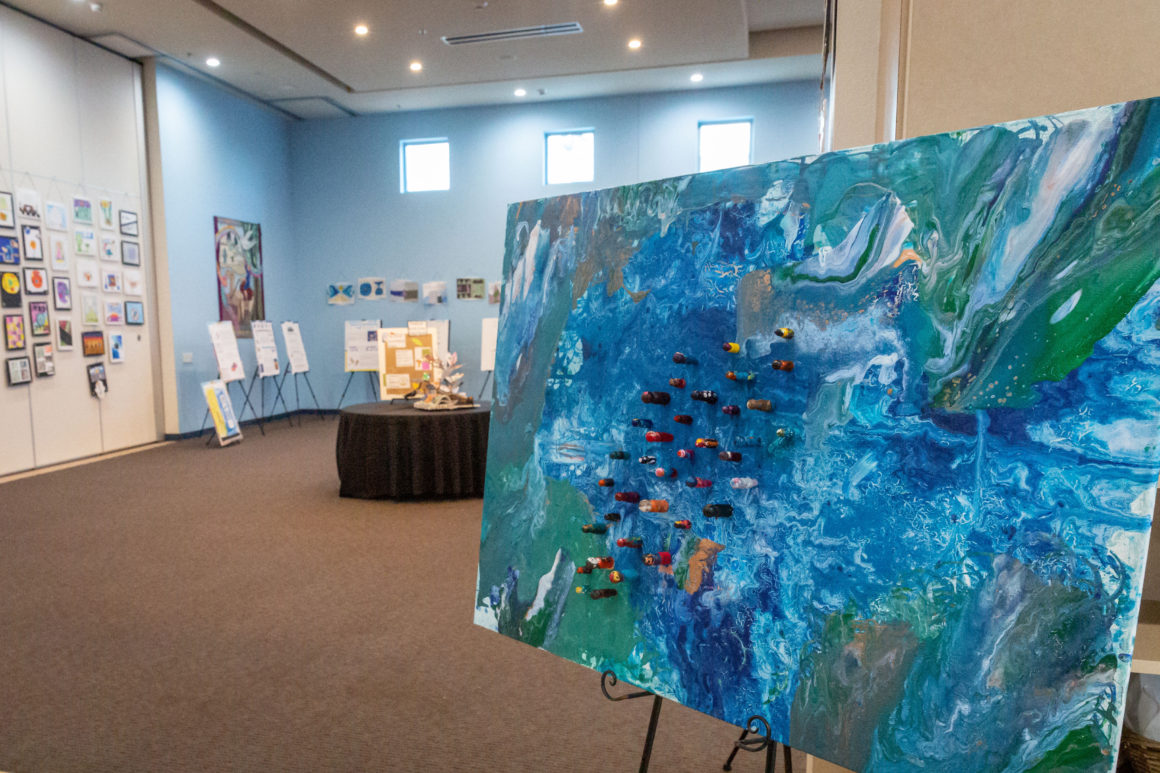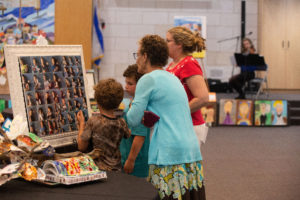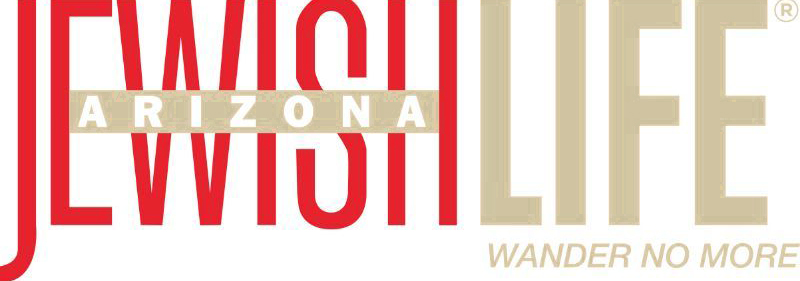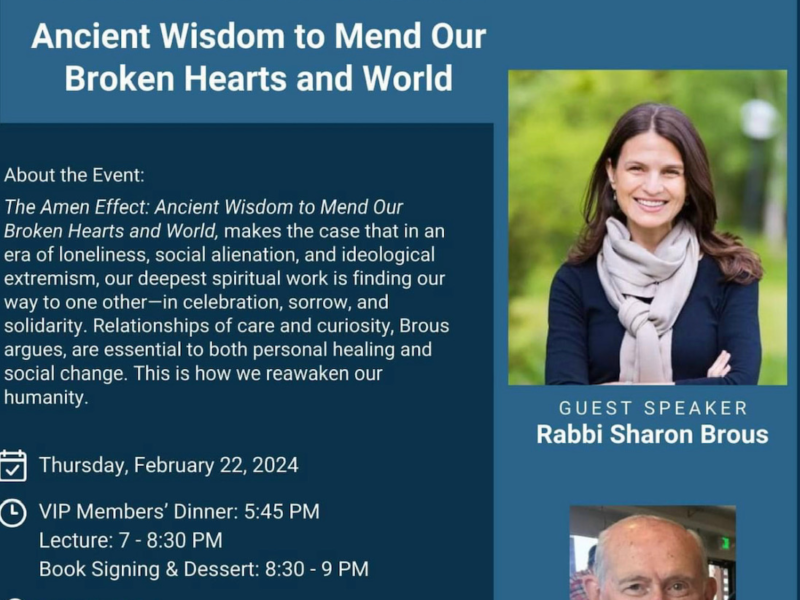Photo: All the students at Pardes Jewish Day School had a hand in creating the Pardes Family Haggadah. Photos credit Josh Mason-Barkin
“I am absolutely stunned,” says Izzy Yetnikoff, father of a kindergarten student at Pardes Jewish Day School in Scottsdale as he explores the Pardes sanctuary turned art museum. In early April the entire space was transformed into an art gallery – worthy of opening night at a trendy museum. Adding to the ambiance, a solo violinist played classical music.
 On display was the Haggadah Project Showcase featuring original artwork, related pieces, and more than 30 oversized page mock-ups of the star attraction – the Pardes Family Haggadah. Remarkably, every Pardes student had a hand in the creation of this truly magnificent book, and each family received a copy for this year’s Passover seder. “I’m really impressed,” continued Mr. Yetnikoff. “I wasn’t expecting something so well done. It makes me proud. My daughter feels inspired that she was part of this, and now this will inspire her to be connected at our seder.”
On display was the Haggadah Project Showcase featuring original artwork, related pieces, and more than 30 oversized page mock-ups of the star attraction – the Pardes Family Haggadah. Remarkably, every Pardes student had a hand in the creation of this truly magnificent book, and each family received a copy for this year’s Passover seder. “I’m really impressed,” continued Mr. Yetnikoff. “I wasn’t expecting something so well done. It makes me proud. My daughter feels inspired that she was part of this, and now this will inspire her to be connected at our seder.”
The Haggadah Project was born from a year-long collaboration between Pardes and the Teacher Institute for the Arts. The overall challenge was to create meaningful and emotionally rich Jewish holiday experiences for the three specific holidays known as the Shalosh Regalim, or the three pilgrimage festivals of Sukkot, Passover and Shavuot. For Passover, the team wanted to incorporate as much of the school into the experience as possible and came up with the idea of an all-school Haggadah.
Along the walls of the galley, pieces were displayed by theme, with artwork representing a selected portion from the text each grade was assigned in Jewish Studies class. Lining the bima, artist Amedeo Modigliani-inspired portraits of the Four Children created a colorful wall of faces. In the center, tables displayed stunning works, including the school’s Book of Life Project, borne from the tragedy of the Pittsburgh Tree of Life Synagogue shooting this past October. Inspired by the Artist Hillel Smith, this deeply moving papier-mâché book is covered in glistening glass mosaics with a tree bough atop, studded in leaves inscribed with the first letter of Pardes’ students’ Hebrew names.
Other displays included Seder plates, plaques, works depicting the Counting of the Omer, teacher projects like Shirat Ha’yam (Song of the Sea), a three-dimensional depiction of the Parting of the Sea, and an entire wall dedicated to Jerusalem, where students expressed their interpretations of this holiest of ancient cities – the city of gold, love, fun, peace, friendship and more.
In preparation for the Haggadah Project, Judaics teachers Jessie Rubenstein and Lauren Mishlove worked with students to explore specific texts and themes associated with the Haggadah. In addition to reading a plethora of texts, interpretations and commentary on haggadot, each class discussed where the texts come from and shared what the texts mean to them. Fourth graders, for example, studied Yachatz, the breaking of the middle matzah which is then turned into the afikomen. They talked about what the three matzah on the table represent, why we break the middle matzah, and what the text most means to them. Many of the students identified the breaking of the matzah as a call to repair the brokenness of the world.
Eighth graders did additional work in Hebrew class on Nirtzah, the concluding section of the Seder, when we say “next year in Jerusalem.” Interpretations included the hope that next year “may we have peace in Jerusalem.” Others experienced the text as recognizing Jerusalem as the heart, and not just a physical place, where presumably when the Messiah comes, all the Jews can return.
Following their studies, Art teacher Orit Feinberg helped the students bring selected texts to life, one page at a time. “Every grade was taught a page of the Haggadah and translated what they learned into the visual,” explains Orit as she walks about the gallery pointing out display areas featuring art depicting Miriam’s Cup, the parting of the Red Sea and the lighting of the candles to name a few. “The idea was to work with different textures, materials and techniques. Students were allowed to use collage, watercolor, pastels, colored pencils and other mediums.” Working closely with a graphic designer, Feinberg spent hours assembling all the artwork for the different grades, selecting the texts and creating the Haggadah.
“The Passover Seder is the most common Jewish ritual performed even by Jews who have no other Jewish affiliation,” says Jessie Rubenstein. “The project really allowed a focused study of this important Pesach tradition and enabled students to find a way to put themselves into Pesach like they may not have been able to do before. The goal was to allow them to feel the connection.”
“One of the beautiful things about the Seder is that there are so many ways that each section can be interpreted,” continues Jessie. “The kids were able to re-think what the seder has meant most to them up to this point. For some, it had been kind of a chore that they had to go through every year. Through this experience, they were able to really connect with their section of this ritual and find deeper meaning in what they were doing. It really changed their notion of what Passover could be.”
Pardes’ work with the Teacher Institute for the Arts adds a valuable framework for students to discover, study and own their Judaism as they mature and grow into themselves. By expanding the learning experience, youth are empowered to become critical thinkers who understand how to interpret text and ask questions of it so they can become more confident in establishing their own opinions.
Looking at all the pieces, it was clear the work isn’t just about art, but the individual expression of the texts that inspire them to “feel” and “own” their creations.
“It’s fantastic,” exclaimed Kate Schwarz, the parent of a second grader. “I absolutely love it! I’ve been going to art galleries my entire life and to introduce kids to that format with their own artwork is wonderful.”






